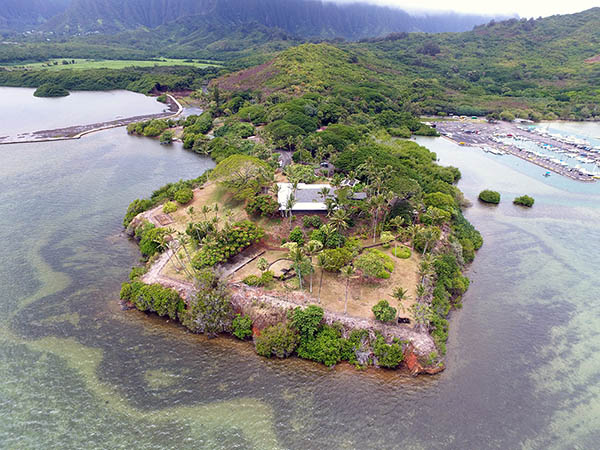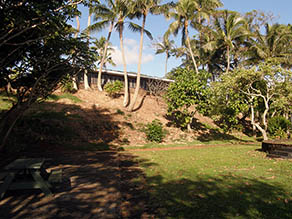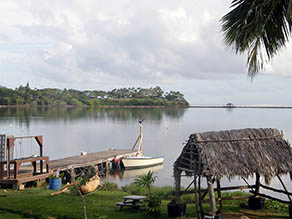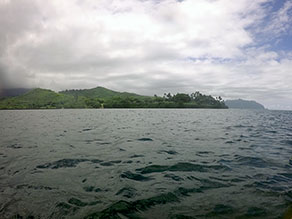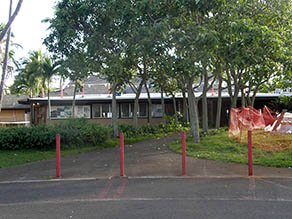 |
 |
 |
 |
||||||
|
|
|
|
|
|
|
|
|
|
|
|
|
|||||||||
 |
“Here we are within the ahupua‘a of He‘eia,” Ian begins, “at the place called Ke‘alohi, and the former site of Kalaeulaula Heiau—you can see the red dirt, ulaula. Polynesian mythology—all mythology really, if you look at the indigenous peoples—are poetic visions encoded with environmental and cultural information that, in this case, bring about the thriving of people born on the sea. “If you show up in a few voyaging canoes, with a small number of people that are your family, the goal is to grow your family—ho‘oulu lāhui. Very different than our modern world. And that was celebrated. But all of the voyaging that happened in Oceania was purposeful. It was by no means one-way, but rather an absolutely dynamic traveling intersection of every point within the tropics. What is it, sixty five thousand islands and two hundred million square miles of ocean, and they found them all? And they returned back to their places of origin. And that’s what’s so important about this place, Ke‘alohi. Ke‘alohi point became a center for observation. We can see three hundred sixty degrees, take away all these non-native tree. So important for understanding. “Hawaiian historian Samuel Kamakau wrote a statement that is probably the most overlooked statement in all of the Hawaiian research. He is talking about Kāne‘ohe bay and he said that the gods laid out the north end of Kāne‘ohe bay as a map of all the known lands on Earth. So if you sit here at Ke‘alohi, we are sitting in the center of the map of all the knowns lands of the people, of the gods. That means you know how to get home. “Konahuanui, sitting here at Ke‘alohi, and then past that is Pu‘u-o-kona. Well, what’s Kona in an older language? Tonga, which is south and west of us. If we walk to the point, one of the lower hills in front of the Kualoa cliffs that actually cradles Waiahole, that point is Pu‘u-o-Kaua‘i. And sure enough, north and west of here over there you find Kaua‘i. This begins to open up.” “There are stories about how Haumea comes from Kilohana down to He‘eia to this place, to Ke‘alohi Point,” Lilikalā says. “In the 1906 story by Poepoe, he talks about how Haumea comes down, and she’s gathering crabs and different kinds of seaweed there. She’s going to take them back up to the mountain. While she is there, Wākea is off looking for mountain food—bananas, yams, hō‘i‘o ferns, freshwater shrimp. They’re going to meet and have a meal together. “Haumea has a premonition while she’s there at Ke‘alohi Point that something has gone terribly wrong with Wākea. That’s the beginning of a long, 41-epic story about Hauma-Wākea, and how she saves him, and how she becomes a great goddess. “This whole great story about earth mother/sky father has to do with this area of He‘eia. What you can learn about the sanctity of those kind of places like Ke‘alohi, where there used to be a temple that measured the sun. Haumea comes through Luluku where Kukuiokāne temple was. It was a temple of at least three platforms coming down the mountain side. "She comes through there, and there’s a special plant that grows in Luluku. Now, this is now the Kāne‘ohe side. We’ve come out of He‘eia into Luluku, which is Kāne‘ohe, up to the cliff of Kilohana, and then she finds that Wākea indeed is in trouble because he’s been captured by the guards of Kumuhonua. Kumuhonua worships Kāne, and Wākea represents a threat to the Kāne worship because he’s coming out of Ra‘iātea. 
“The heiau around the corner is Kalāhiki heiau,” Ian adds. “Here’s the ka-lā-hiki, if you will, the pathway [of the sun] leading in. I’ve never watched the sun at the solstice and the equinoxes from this place, but I would like to because I’m sure it’s quite significant, and we could probably see the structure of the heiau as marking where the sun rises and sets. like the research on Puakea up there. “What’s the declination of the star that rises at that latitude? It’s twenty three and a half degrees south of east. That's none other than Sirius, the dog star, which was once called ‘A‘ā—the great white bird of Kāne. So here is this mythology that sitting at Puakea heiau: I could look and see the chant physically embodied in the landscape, leading me to a place that’s east but south towards Tahiti. "Now it wasn’t until at the funeral of Ka‘au McKinney, a navigator of the Polynesian Voyaging Society, that Nainoa Thomson, the navigator, said ‘You have to go east to go south to Tahiti.’ Turns out Taputapuatea is in a straight direct line south, you go straight south and you will find the sister heaiu of this one here in Ko‘olau, of Puakea. You will find Taputapuatea. Down there is Ra‘iātea, Hawaiki. “So here was the lay-line to that place. But in order to voyage there, you don’t want to go straight south because then you’re going to have to beat against the Tokelau—the Ko‘olau winds. So you have to go east so you can do what Carlos Andrade said: sail downwind into your place. But you have to be careful, you don’t want to get stuck in the bay once you get there. "I know that they were voyaging upwind to find islands, but now they found the new location, beating upwind to the island no good, so you sail and come down. And he said ‘You have to go East to go south to Tahiti,’ and that’s when I realized, My gosh! And sure enough, the great-circle route, the voyaging pathway is exactly that. So we start to understand that concept of Kāne‘ohe and Ko‘olau Bay being a map of all the known lands of the Earth. “And Ke‘alohi is the center of it all, like it is the center of all the heavens. So my question is, can we say there is a mythical but a real island is somewhere out there—Ke‘alohi—where these people are raised, or was that the mythical side of it, so that the poetic vision could be displayed?” “Ke‘alohi today is called He‘eia State Park,” Mahealani says. “It’s also the location of the heiau Kalaeulaula. It might have been named for the red dirt of the hillside before those grasses grew over it, but it was considered a leina, a leaping-off point by Hawaiians in ancient times. When a Hawaiian from the area died, his soul would travel to the leina at He‘eia at Ke‘alohi, and there he would be judged. And if he led a good life, his kūpuna, his ancestors’ ‘aumakua would receive him into the realm of ‘aumakua. And if he didn’t, he would be rejected, and he would become a wandering spirit. That’s one of the stories about the area. “There are the two sections of He‘eia,” Kalani elaborates. “He‘eia Kea and He‘eia Uli. The leina separates the two portions of the He‘eia. He‘eia Kea was where the ali‘i lived, and He‘eia Uli was where the commoners lived. Kea meaning white. So that’s on the Kāne‘ohe side of Ke‘alohi point, and the other side is where the commoners lived. He‘eia Uli. Uli, meaning dark. “In Ra‘iātea, they believe the world is the center of the universe,” Lilikalā points out, “and the world is divided. So, the Paoa-uli priests go to the east where you have the uli clouds, the dark rainclouds, the Paoa-tea priests go to the west where you have the white, fluffy clouds with no rain. That’s why there’s He‘eia Kea and He‘eia Uli. He‘eia Uli is on this side, He‘eia Kea on that side. That name comes out of the Paoas that come out of Ra‘iātea.” “The big hall that they have banquets in is actually situated right on top of the heiau,” Mahealani continues. “A few years ago our club made a bid to manage the property when it was up for a bid, and we wanted to raze that building and rebuild a new banquet hall at the mauka end of the park, because that area is not as kapu an area as where the banquet hall is. We didn’t win the bid, but we still think that should be done some day.” Read about issues regarding burials at Ke‘alohi 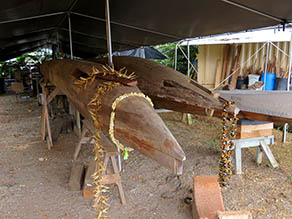
“The state park was created actually in the 1978,” Rocky relates. “I was there. We did the blessing on the park. Why we made it into a state park? There was Ulu Mau Village there. I was a tour guide. It was a replica of an ancient Hawaiian village. So, I did the tour there. Me and a friend of ours, it was Malia Solomon that put it together. Plenty hale in there, grass hales. "Even my children worked in there. They pounded the poi and stuff. And then they wanted to build a hotel there. So we pushed the state to purchasing it for a state park, which they did. To make it a cultural park, to keep it away from tourism. Now they’re turning it into a tourist business, and that’s not what we wanted the park for. We wanted to preserve the land.”
“Bobby Puakea is a friend of ours,” Rocky says. “Bobby is one of the last of the kahuna kālai wa‘a. It’s very hard to get kāhuna kālai wa‘a here on O‘ahu especially. He’s actually related to my husband. Bobby’s family goes way back from Hawai‘i Island. My husband’s family goes way back to Hawai‘i Island too. But it’s good he’s there, cultural things like that, it’s good to have that in the park. Nothing wrong with that. And it’s not for tourists; it’s educational.”
|
 |
|||||||
 |
Far uphill from Ke‘alohi Point, in ‘Ioleka‘a Valley, sits Leleahina Heiau.
|
 |
||
 |
|
 |
||
